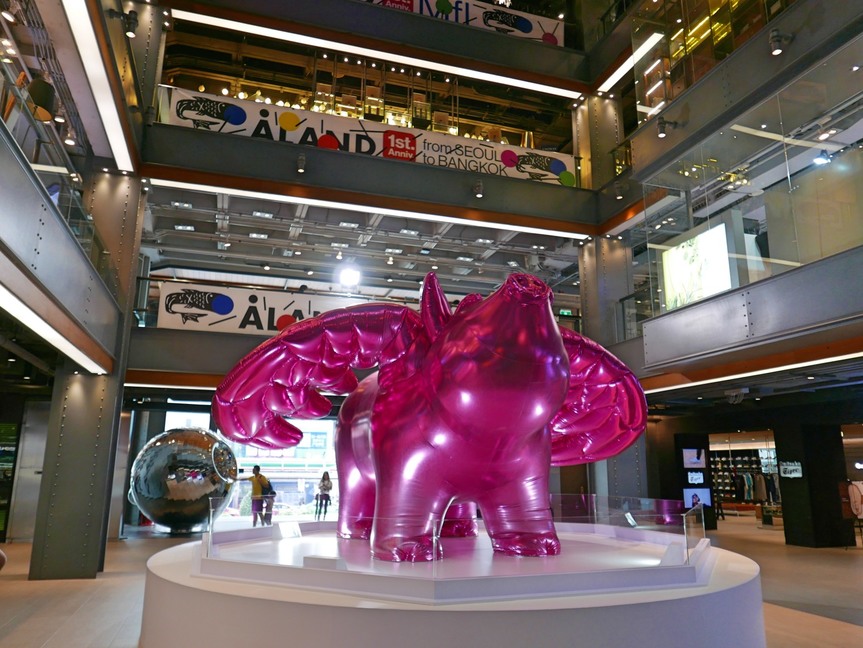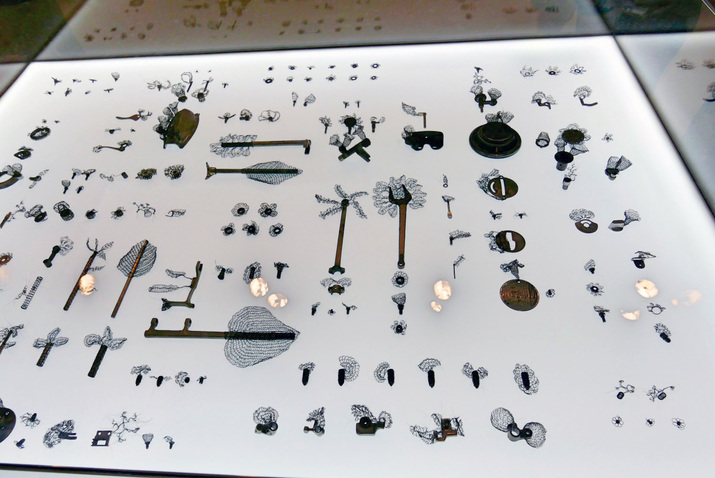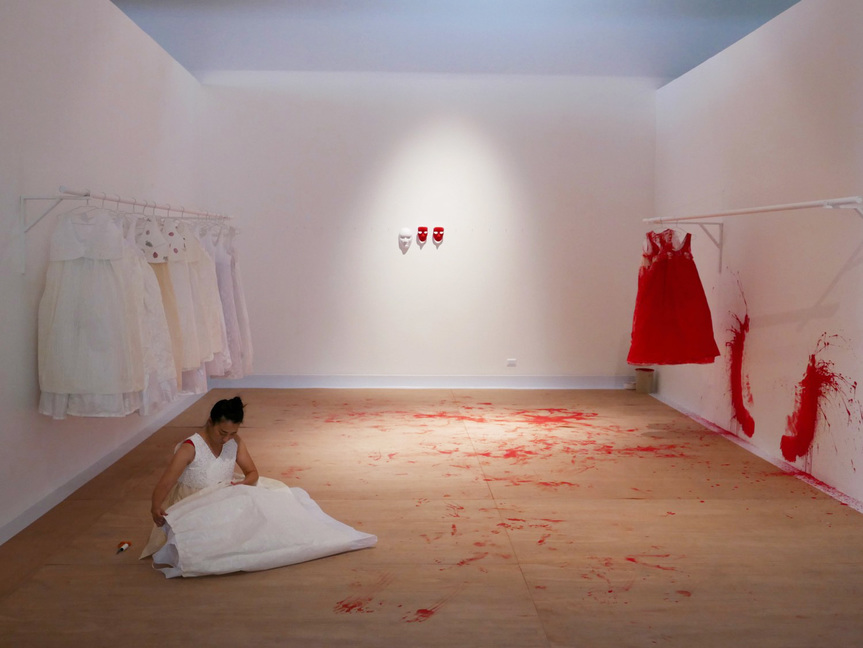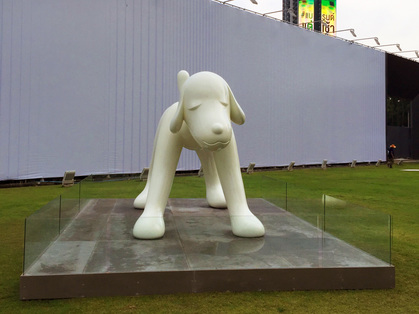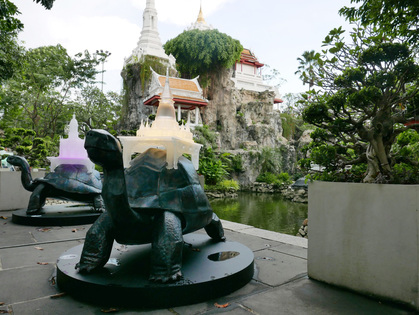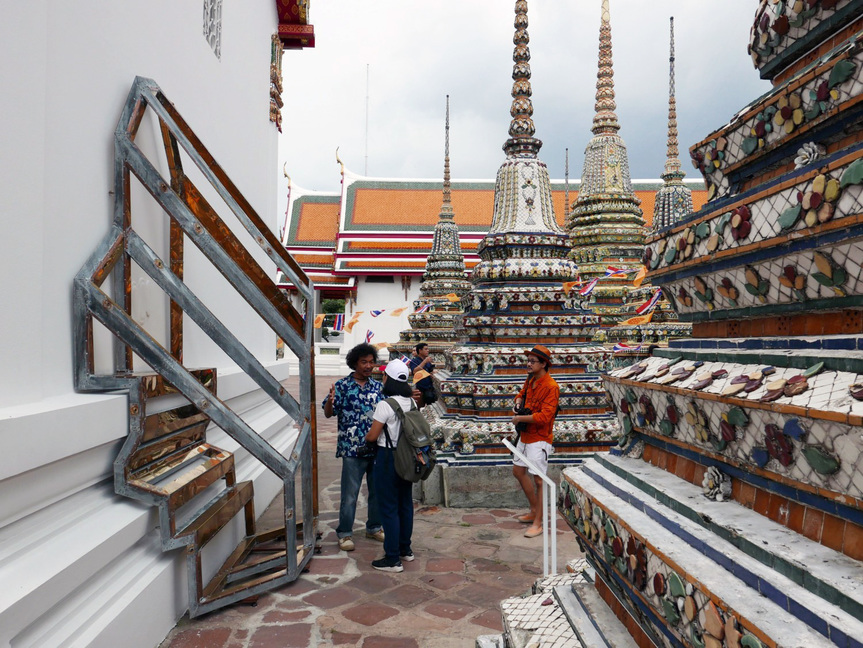
R
E
V N
E
X
T
Bangkok Art Biennale 2018: “Beyond Bliss”
ELMGREEN & DRAGSET’s Zero (2018), a swimming-pool-shaped, Zen symbol of nothingness, and a portal from the Chao Phraya River to the Nordic seas. All photos by HG Masters for ArtAsiaPacific.
Why launch a new biennial, in Asia, in Southeast Asia, in 2018? In the last 18 months, curator and art historian Apinan Poshyananda, the artistic director of the inaugural Bangkok Art Biennale (BAB), has fielded questions from domestic and international colleagues on exactly this subject—and he has answers. First of all, he said at the press conference on October 16 at the Bangkok Art and Culture Centre (BACC, an institution he established in 2005 and which opened in 2008), “Bangkok has been waiting for a long time.” Belatedness is no longer a reason not to launch a new initiative. Furthermore, as the current director of the BACC Pawit Mahasarinand made clear in his welcome speech, the Bangkok Metropolitan Administration (BMA) has slashed its funding for the BACC, and many people in the art scene believe the government wants to sell off the building’s prime real estate to transform it into another high-end shopping mall like those adjacent to the Pathum Wan Junction. In the face of that possibility, the dance and theater critic Pawit protested, “Art is important—and we need art in this city.”
The BAB certainly delivers art to Bangkok—by 75 artists to 20 locations around the city, from art spaces to shopping malls, temples, banks, high-end hotels and historical buildings on the Chao Phraya river. To pull off this feat, Apinan worked with three experienced curators: Patrick Flores, a professor at the University of the Philippines and the artistic director for the next Singapore Biennale; Adele Tan, senior curator at the National Gallery Singapore; and Luckana Kunavichayanont, the former director of BACC, along with assistants Sansern Milindasuta and Wutigorn Kongka. Hundreds of thousands of residents and tourists will see Choi Jeong-Hwa’s inflatable, shiny-pink sculptures of winged pigs and Yayoi Kusama’s polka-dot pumpkin-balloons in the shopping malls, or Pannaphan Yodmanee’s miniature paintings of Sino-Siamese trade around the shrine-like Khao Mor inside Wat Pho. It was a free citywide festival, and the magnanimity of that gesture was apparent.
At the same time, there were more nakedly promotional reasons for the BAB. The project wouldn’t have been realized without the support of ThaiBev CEO Thapana Sirivadhanabhakdi, who is chairman and co-founder of the BAB Foundation and whose company is one of four major corporate sponsors committed to the BAB for the first three editions (2018, 2020, 2022), along with real-estate conglomerates Central Bangkok, Siam Piwat and One Bangkok, the 41-acre, USD 3.5 billion real-estate development overseen by Thapana’s younger brother, Panote. Thapana said at the press conference that “art is truly a tool” to create a positive impact on society. He added that “art is soft power” and the BAB offers a key opportunity to “promote Bangkok as a top global tourist destination to attract tourists and art lovers from around the world.” The BAB also won support from the Ministry of Tourism and Sport, and the BMA—two bureaucracies that, under the current military government, are seeking to slash cultural funding.
Even those critical of his outsized role in Thailand’s art scene admit that only Apinan could have stitched this legion of supporters together under a single banner of a contemporary art biennale. The BAB’s theme itself reflected the paradoxical conjunctions of the event’s support structures. Apinan explains in his curatorial statement that the biennial, titled “Beyond Bliss,” looked at an age of “disruption, delusion and fear,” and asserted that “losing faith in god-less zones and our inability to predict the future result in insecurity and panic.” The idea, Apinan continues, is that “‘Beyond Bliss’ is the state of neither happiness nor sorrow . . . [it is] intentionally paradoxical and open-ended.” That said, the first issue of the BAB’s self-published magazine included in its introduction this line: “While some people seek happiness from larger things such as peace, democracy and human rights, some are satisfied by the sound of a bird, a nice meal with loved-ones and good health, the diversity of which prompted us to ask ourselves what is happiness.”
For many artists responding to the theme, “Beyond Bliss” translated into a chronicle of suffering. At the BACC many works looked at the exploitation of women. Performance art pioneer Chumpon Apisuk’s video I Have Dreams (2018), for instance, portrayed Chiang Mai sex workers talking about their life aspirations, while the textile work Mida Tapestry (2011) was made by sex workers who were caught in a raid on a karaoke bar. Imhathai Suwatthanasilp’s No More Sewing Machine (2018) sculptures are made from the hair of sex workers, and draw attention to the many women trapped between low-end jobs in the textile industry and the night-life trade. On the same floor were more works looking at the exploitation of women, including Nge Lay’s door-sized, mixed-textile sculpture The Check Point (2018) shaped like a vagina. Several other works explored regional politics and migration. The diverse fabric and multimedia works by the five-member, all-female Muslimah Collective reflect on life in Thailand’s two southern Muslim-majority provinces that have been wracked by anti-government insurgencies and fierce state crackdowns. Sherman Ong’s unflinching video portrays an Afghan woman who migrated to Malaysia talking about her journey and new life. Upstairs, along the ramp, was Firoz Mahmud’s photographic series “Soaked Dream” (2018), of Rohingya refugees wearing green-painted eyewear made from camera parts while they imagine brighter futures. Looking at the Rohingya’s forced exile from Myanmar, Jakkai Siributr’s documentary video is paired with flags woven from Burmese textiles and incorporates elements of different national flags, creating a jumble of national symbols more representative of the world today than the solid colors and forms of the flags we know.
The BACC’s eighth floor was occupied by the Marina Abramović Institute (MAI), a cultish display of the performance artist’s disciples engaged in long-durational performances in the manner of their master. South Korean Jihyun Youn was stitching a wedding dress that she then doused in red paint at the end of each day; Gurugram artist Vandana stared at a candle all day long; Burmese artist Lin Htet imprisoned himself in a razor-wire lined cage for three weeks; Tehran artist Pantea ran in circles around a square steel sheet with a rope around her neck connected to pieces of chalk. The actual individual physical feats of these performers shouldn’t be trivialized, but it was unclear why any artist would submit to being exhibited under the Abramović brand in this manner. If you cared to be indoctrinated yourself, the other half of the floor gave viewers the chance to learn the Abramović method. This involves a series of breathing and movement exercises and then being led with eyes closed around the space, sitting at a desk and separating a pile of rice into different colored grains and counting them, staring at primary-colored sheets of paper, and lying in individual cots in the galleries. If it sounds horrific, let me assure you that it was, and yet there were dozens of people absorbed in their training. The cult of personality is strong in humans, which says everything about the resurgence of brutal strongmen in our era.
From the pumpkins by Yayoi Kusama and flying pigs by Choi Jeong-hwa, to the dog sculptures by Yoshitomo Nara (Your Dog, 2017) at the BAB Box venue and Aurèle (LostDog Ma Long, 2018) outside the Mandarin Oriental, a fair quantity of the work in “Beyond Bliss” could be better thought of as “beyond kitsch.” (The same goes for the field of contemporary art at large, with best-selling figures like Jeff Koons, Damien Hirst and Takashi Murakami being prime examples.) In the same way that Apinan conceived of “Beyond Bliss” as a state of wisdom that supersedes material happiness or desires that will guide humans “to our own pursuits in life,” these artworks appear to defy the classical formulation of kitsch as mass-produced consumer goods (even though they are largely produced by teams of fabricators), while also appealing to the same instincts of instantly pleasing superficiality in their obvious pop-cultural irony and manipulation of artistic tropes.
Many other artworks in the BAB walk a fine line between carefully considered, site-specific artworks and falling into the traps of “beyond kitsch” in their usage of familiar symbols. Krit Ngamsom’s tortoise sculptures at Wat Prayoon’s Mount Sumeru, for instance, bear LED-illuminated models of nearby religious institutions on their backs, celebrating the area’s multiculturalism while glossing over whatever inter-religious tension surely existed through the centuries. Similarly, Komkrit Tepthian’s Giant Twins (2018), a “Siamese” twin sculpture made from figures of Chinese warriors and Yaksa from the Wat Pho and Wat Arun, respectively, represent the Chinese and Khmer cultures that together comprise Thai identity—though that subject is surely more contested than the artwork represents. Even Nino Sarabutra’s beautifully installed project of 125,000 porcelain skulls What Will We Leave Behind (2012), arrayed on the ground around the bell-shaped, white-painted stupa at Wat Prayoon and on which you could walk barefoot while contemplating life and death, exists in the realm of familiar symbolism creatively deployed.
More nuanced takes on the “Beyond Bliss” concept were those that avoided overt, simple representations. Several works achieved this through abstraction. Tawatchai Puntusawasdi’s A Shadow of Giving (2018), is a compressed-looking architectural form made of brass, copper and galvanized steel at Wat Pho, based on two-dimensional paintings of almshouses. His mentor Montien Boonma’s Zodiac Houses (1998–99) are model towers propped up on stilts; viewers can walk underneath them and look up at holes punctured in their surfaces that resemble constellations, creating an unexpected relationship between viewer and object. Sanitas Pradittasnee made a bold intervention into Wat Arun’s traditional landscape in Across the Universe and Beyond (2018) by fencing in the Khao Mor with red acrylic walls and creating a shrine out of mirrored forms. Despite its contemporary-looking form, the installation evokes her research into the Traibhumi, the Buddhist conception of the Three Worlds, which informs the architecture of the temple.
Other strong works dug deeper into their contexts, like the many works at the BACC looking at the place of women in Thailand today. While Mark Justiniani’s mirrored-room installation The Settlement (2016–17) references traumas of the Philippines’ history, one of the only historical perspectives on Thailand itself was Anupong Charoenmitr’s two-channel video at the former East Asiastic warehouse, Something Like a Thing, Sometime Like Every Time (2018). The work portrays the dilapidated building in Bangkok next to the East Asiatic Company’s still-pristine interior in Copenhagen, where founder Hans Neils Anderson sold Thai teak to make European furniture and provided much aesthetic pleasure to the continent. “Beyond Bliss” largely skirted historical topics—which might have proven contentious in a highly censorious environment. Yet in staying close to the anxieties and ills of the present, without delving into how and why things are this way, there’s a limitation to what can be understood, and what can be done. In this way “Beyond Bliss” obviously attempted to be beyond politics, though the topic’s absence made it even more conspicuous.
HG Masters is the editor-at-large of ArtAsiaPacific.
The inaugural Bangkok Art Biennale, “Beyond Bliss,” is on view until February 3, 2019.
To read more of ArtAsiaPacific’s articles, visit our Digital Library.

